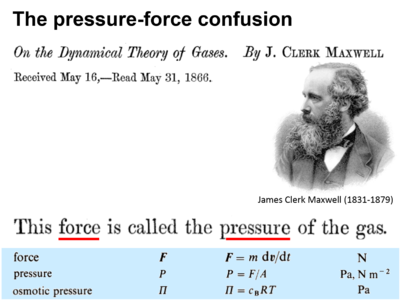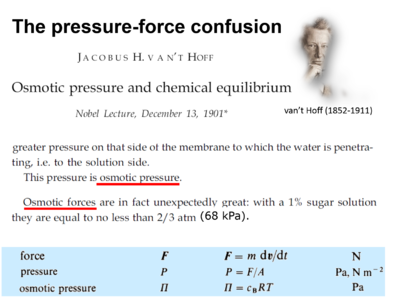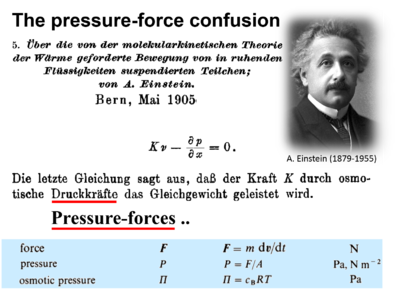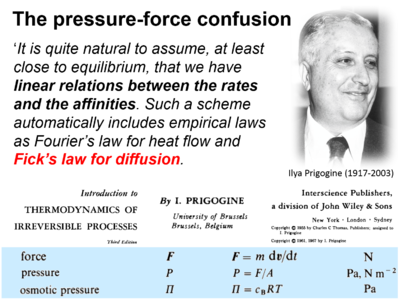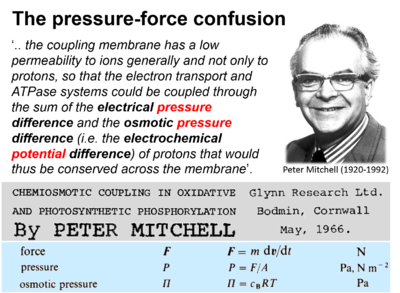Difference between revisions of "Pressure"
| Line 3: | Line 3: | ||
|description='''Pressure''' [Pa = J·m<sup>-3</sup>] is the concentration of the [[force]] at the point of [[action]]. More generally, pressure is the force times concentration at the interphase of interaction. | |description='''Pressure''' [Pa = J·m<sup>-3</sup>] is the concentration of the [[force]] at the point of [[action]]. More generally, pressure is the force times concentration at the interphase of interaction. | ||
In addition to mechanical pressure, hydrostatic pressure, barometric pressure, | In addition to mechanical pressure, hydrostatic pressure, barometric pressure, gas pressure ([[oxygen pressure]]), isomorphic pressures are distinguished as [[osmotic pressure]], [[diffusion pressure]], [[reaction pressure]], and even [[electric pressure]]. In [[ergodynamics]], the pressure in a transformation, Δ<sub>tr</sub>''Π'', is the product of [[free activity]] times [[force]], Δ<sub>tr</sub>''Π'' = ''α''<sub>tr</sub>·Δ<sub>tr</sub>''F'' [mol·m<sup>-3</sup> · J·mol<sup>-1</sup> = J·m<sup>-3</sup> = Pa]. | ||
In the classical physicochemical literature, there is some confusion between the terms force and pressure: ''"This force is called the pressure of the gas"'' by [[Maxwell 1867 Phil Trans Royal Soc London |Maxwell (1867)]]; ''"Pressure forces"'' by [[Einstein 1905 Ann Physik 549 |Einstein (1905)]]; presentation of ''Fick's law of diffusion'' (which represents a flux-pressure relationship) as a flux-force relationship by [[Prigogine 1967 Interscience |Prigogine (1967)]]. | In the classical physicochemical literature, there is some confusion between the terms force and pressure: ''"This force is called the pressure of the gas"'' by [[Maxwell 1867 Phil Trans Royal Soc London |Maxwell (1867)]]; ''"This pressure is osmotic pressure. .. Osmotic forces are in fact .."'' by [[Van't Hoff 1901 Nobel Lecture |van't Hoff 1901]]; ''"Pressure-forces"'' by [[Einstein 1905 Ann Physik 549 |Einstein (1905)]]; presentation of ''Fick's law of diffusion'' (which represents a flux-pressure relationship) as a flux-force relationship by [[Prigogine 1967 Interscience |Prigogine (1967)]]. | ||
|info=[[Gnaiger 1989 Energy Transformations]]; [[Gnaiger 2017 MiP2017]] | |info=[[Gnaiger 1989 Energy Transformations]]; [[Gnaiger 2017 MiP2017]] | ||
}} | }} | ||
Comunicated by [[Gnaiger E |Erich Gnaiger]] 2018-09-16 | |||
<gallery mode=default perrow=2 widths="400px" heights="300px"> | |||
File:Pressure-force Maxwell.png | |||
File:Pressure-force van't Hoff.png | |||
File:Pressure-force Einstein.png | |||
File:Pressure-force Prigogine.png | |||
File:Pressure-force Mitchell.png | |||
|- | |||
</gallery> | |||
{{MitoPedia concepts | {{MitoPedia concepts | ||
|mitopedia concept=MiP concept, Ergodynamics | |mitopedia concept=MiP concept, Ergodynamics | ||
}} | }} | ||
Revision as of 09:51, 16 September 2018
Description
Pressure [Pa = J·m-3] is the concentration of the force at the point of action. More generally, pressure is the force times concentration at the interphase of interaction.
In addition to mechanical pressure, hydrostatic pressure, barometric pressure, gas pressure (oxygen pressure), isomorphic pressures are distinguished as osmotic pressure, diffusion pressure, reaction pressure, and even electric pressure. In ergodynamics, the pressure in a transformation, ΔtrΠ, is the product of free activity times force, ΔtrΠ = αtr·ΔtrF [mol·m-3 · J·mol-1 = J·m-3 = Pa].
In the classical physicochemical literature, there is some confusion between the terms force and pressure: "This force is called the pressure of the gas" by Maxwell (1867); "This pressure is osmotic pressure. .. Osmotic forces are in fact .." by van't Hoff 1901; "Pressure-forces" by Einstein (1905); presentation of Fick's law of diffusion (which represents a flux-pressure relationship) as a flux-force relationship by Prigogine (1967).
Abbreviation: P, p, Π
Reference: Gnaiger 1989 Energy Transformations; Gnaiger 2017 MiP2017
Comunicated by Erich Gnaiger 2018-09-16
MitoPedia concepts: MiP concept, Ergodynamics

